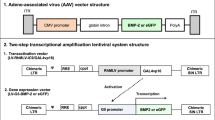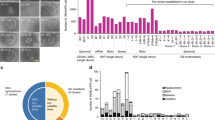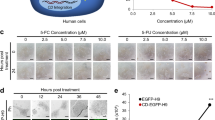Abstract
Integrating vectors can lead to the dysregulation of nearby chromosomal genes, with important consequences for clinical trials and cellular engineering. This includes the retroviral and lentiviral vectors commonly used for deriving induced pluripotent stem cells (iPSCs). We previously used integrating foamy virus (FV) vectors expressing OCT4, SOX2, MYC and KLF4 to reprogram osteogenesis imperfecta mesenchymal stem cells (MSCs). Here, we have studied the effects of 10 FV vector proviruses on neighboring gene expression in four iPSC lines and their corresponding iPSC-derived MSC (iMSCs). Gene expression profiles in these iPSC lines showed that none of the 38 genes within 300 kb up- or downstream of integrated proviruses had a significant difference in mRNA levels, including five genes with proviruses in their transcription units. In the iMSCs derived from these iPSCs, the same type of analysis showed a single dysregulated transcript out of 46 genes found near proviruses. This frequency of dysregulation was similar to that of genes lacking nearby proviruses, so it may have been due to interclonal variation and/or measurement inaccuracies. While the number of integration sites examined in this paper is limited, our results suggest that integrated FV proviruses do not impact the expression of chromosomal genes in pluripotent human stem cells or their differentiated derivatives. This interpretation is consistent with previous reports that FV vectors have minimal genotoxicity, even when integrating near or within genes.
This is a preview of subscription content, access via your institution
Access options
Subscribe to this journal
Receive 12 print issues and online access
$259.00 per year
only $21.58 per issue
Buy this article
- Purchase on Springer Link
- Instant access to full article PDF
Prices may be subject to local taxes which are calculated during checkout




Similar content being viewed by others
References
Hacein-Bey-Abina S, Von Kalle C, Schmidt M, McCormack MP, Wulffraat N, Leboulch P et al. LMO2-associated clonal T cell proliferation in two patients after gene therapy for SCID-X1. Science 2003; 302: 415–419.
Howe SJ, Mansour MR, Schwarzwaelder K, Bartholomae C, Hubank M, Kempski H et al. Insertional mutagenesis combined with acquired somatic mutations causes leukemogenesis following gene therapy of SCID-X1 patients. J Clin Invest 2008; 118: 3143–3150.
Ott MG, Schmidt M, Schwarzwaelder K, Stein S, Siler U, Koehl U et al. Correction of X-linked chronic granulomatous disease by gene therapy, augmented by insertional activation of MDS1-EVI1, PRDM16 or SETBP1. Nat Med 2006; 12: 401–409.
Krause D . Gene therapy for Wiskott–Aldrich syndrome: benefits and risks. The Hematologist 2011; 8: 10.
Modlich U, Bohne J, Schmidt M, von Kalle C, Knoss S, Schambach A et al. Cell-culture assays reveal the importance of retroviral vector design for insertional genotoxicity. Blood 2006; 108: 2545–2553.
Montini E, Cesana D, Schmidt M, Sanvito F, Ponzoni M, Bartholomae C et al. Hematopoietic stem cell gene transfer in a tumor-prone mouse model uncovers low genotoxicity of lentiviral vector integration. Nat Biotech 2006; 24: 687–696.
Zychlinski D, Schambach A, Modlich U, Maetzig T, Meyer J, Grassman E et al. Physiological promoters reduce the genotoxic risk of integrating gene vectors. Mol Ther 2008; 16: 718–725.
Hargrove PW, Kepes S, Hanawa H, Obenauer JC, Pei D, Cheng C et al. Globin lentiviral vector insertions can perturb the expression of endogenous genes in [beta]-thalassemic hematopoietic cells. Mol Ther 2008; 16: 525–533.
Winkler T, Cantilena A, Métais J-Y, Xu X, Nguyen A-D, Borate B et al. No evidence for clonal selection due to lentiviral integration sites in human induced pluripotent stem cells. Stem Cells 2010; 28: 687–694.
Ronen K, Negre O, Roth S, Colomb C, Malani N, Denaro M et al. Distribution of lentiviral vector integration sites in mice following therapeutic gene transfer to treat [beta]-thalassemia. Mol Ther 2011; 19: 1273–1286.
Biasco L, Ambrosi A, Pellin D, Bartholomae C, Brigida I, Roncarolo MG et al. Integration profile of retroviral vector in gene therapy treated patients is cell-specific according to gene expression and chromatin conformation of target cell. EMBO Mol Med 2011; 3: 89–101.
Modlich U, Navarro S, Zychlinski D, Maetzig T, Knoess S, Brugman MH et al. Insertional transformation of hematopoietic cells by self-inactivating lentiviral and gammaretroviral vectors. Mol Ther 2009; 17: 1919–1928.
Cavazzana-Calvo M, Payen E, Negre O, Wang G, Hehir K, Fusil F et al. Transfusion independence and HMGA2 activation after gene therapy of human beta-thalassaemia. Nature 2010; 467: 318–322.
Maruggi G, Porcellini S, Facchini G, Perna SK, Cattoglio C, Sartori D et al. Transcriptional enhancers induce insertional gene deregulation independently from the vector type and design. Mol Ther 2009; 17: 851–856.
Kane NM, Nowrouzi A, Mukherjee S, Blundell MP, Greig JA, Lee WK et al. Lentivirus-mediated reprogramming of somatic cells in the absence of transgenic transcription factors. Mol Ther 2010; 18: 2139–2145.
Trobridge G, Josephson N, Vassilopoulos G, Mac J, Russell DW . Improved foamy virus vectors with minimal viral sequences. Mol Ther 2002; 6: 321–328.
Russell DW, Miller AD . Foamy virus vectors. J Virol 1996; 70: 217–222.
Moebes A, Enssle J, Bieniasz PD, Heinkelein M, Lindemann D, Bock M et al. Human foamy virus reverse transcription that occurs late in the viral replication cycle. J Virol 1997; 71: 7305–7311.
Yu SF, Sullivan MD, Linial ML . Evidence that the human foamy virus genome is DNA. J Virol 1999; 73: 1565–1572.
Trobridge GD, Miller DG, Jacobs MA, Allen JM, Kiem HP, Kaul R et al. Foamy virus vector integration sites in normal human cells. Proc Natl Acad Sci USA 2006; 103: 1498–1503.
Hendrie PC, Huo Y, Stolitenko RB, Russell DW . A rapid and quantitative assay for measuring neighboring gene activation by vector proviruses. Mol Ther 2008; 16: 534–540.
Bauer TR, Allen JM, Hai M, Tuschong LM, Khan IF, Olson EM et al. Successful treatment of canine leukocyte adhesion deficiency by foamy virus vectors. Nat Med 2008; 14: 93–97.
Ohmine K, Li Y, Bauer TR, Hickstein DD, Russell DW . Tracking of specific integrant clones in dogs treated with foamy virus vectors. Hum Gene Ther 2011; 22: 217–224.
Deyle DR, Khan IF, Ren G, Wang PR, Kho J, Schwarze U et al. Normal collagen and bone production by gene-targeted human osteogenesis imperfecta iPSCs. Mol Ther 2012; 20: 204–213.
Tsukiyama T, Niwa O, Yokoro K . Mechanism of suppression of the long terminal repeat of Moloney leukemia virus in mouse embryonal carcinoma cells. Mol Cell Biol 1989; 9: 4670–4676.
Hwang NS, Varghese S, Lee HJ, Zhang Z, Ye Z, Bae J et al. In vivo commitment and functional tissue regeneration using human embryonic stem cell-derived mesenchymal cells. Proc Natl Acad Sci USA 2008; 105: 20641–20646.
Greenman C, Stephens P, Smith R, Dalgliesh GL, Hunter C, Bignell G et al. Patterns of somatic mutation in human cancer genomes. Nature 2007; 446: 153–158.
Prickett TD, Agrawal NS, Wei X, Yates KE, Lin JC, Wunderlich JR et al. Analysis of the tyrosine kinome in melanoma reveals recurrent mutations in ERBB4. Nat Genet 2009; 41: 1127–1132.
Ding L, Getz G, Wheeler DA, Mardis ER, McLellan MD, Cibulskis K et al. Somatic mutations affect key pathways in lung adenocarcinoma. Nature 2008; 455: 1069–1075.
Soung YH, Lee JW, Kim SY, Wang YP, Jo KH, Moon SW et al. Somatic mutations of the ERBB4 kinase domain in human cancers. Int J Cancer 2006; 118: 1426–1429.
Recchia A, Bonini C, Magnani Z, Urbinati F, Sartori D, Muraro S et al. Retroviral vector integration deregulates gene expression but has no consequence on the biology and function of transplanted T cells. Proc Natl Acad Sci USA 2006; 103: 1457–1462.
Li CL, Xiong D, Stamatoyannopoulos G, Emery DW . Genomic and functional assays demonstrate reduced gammaretroviral vector genotoxicity associated with use of the cHS4 chromatin insulator. Mol Ther 2009; 17: 716–724.
Arumugam PI, Higashimoto T, Urbinati F, Modlich U, Nestheide S, Xia P et al. Genotoxic potential of lineage-specific lentivirus vectors carrying the beta-globin locus control region. Mol Ther 2009; 17: 1929–1937.
Almarza D, Bussadori G, Navarro M, Mavilio F, Larcher F, Murillas R . Risk assessment in skin gene therapy: viral-cellular fusion transcripts generated by proviral transcriptional read-through in keratinocytes transduced with self-inactivating lentiviral vectors. Gene Ther 2011; 18: 674–681.
Du Y, Jenkins NA, Copeland NG . Insertional mutagenesis identifies genes that promote the immortalization of primary bone marrow progenitor cells. Blood 2005; 106: 3932–3939.
Moiani A, Paleari Y, Sartori D, Mezzadra R, Miccio A, Cattoglio C et al. Lentiviral vector integration in the human genome induces alternative splicing and generates aberrant transcripts. J Clin Invest 2012; 122: 1653–1666.
Knight S, Zhang F, Mueller-Kuller U, Bokhoven M, Gupta A, Broughton T et al. Safer, silencing-resistant lentiviral vectors: optimization of the ubiquitous chromatin-opening element through elimination of aberrant splicing. J Virol 2012; 86: 9088–9095.
Chamberlain JR, Deyle DR, Schwarze U, Wang P, Hirata RK, Li Y et al. Gene targeting of mutant COL1A2 alleles in mesenchymal stem cells from individuals with osteogenesis imperfecta. Mol Ther 2008; 16: 187–193.
Tucker KL, Wang Y, Dausman J, Jaenisch R . A transgenic mouse strain expressing four drug-selectable marker genes. Nucleic Acids Res 1997; 25: 3745–3746.
Yu J, Hu K, Smuga-Otto K, Tian S, Stewart R, Slukvin II et al. Human induced pluripotent stem cells free of vector and transgene sequences. Science 2009; 324: 797–801.
Acknowledgements
This research was funded by NIH grants AR48328, AR48328-09S1, DK55759, GM86497, HL53750 and AR53917.
Author information
Authors and Affiliations
Corresponding author
Ethics declarations
Competing interests
The authors declare no conflict of interests.
Additional information
Supplementary Information accompanies the paper on Gene Therapy website
Supplementary information
Rights and permissions
About this article
Cite this article
Deyle, D., Khan, I., Ren, G. et al. Lack of genotoxicity due to foamy virus vector integration in human iPSCs. Gene Ther 20, 868–873 (2013). https://doi.org/10.1038/gt.2013.6
Received:
Revised:
Accepted:
Published:
Issue Date:
DOI: https://doi.org/10.1038/gt.2013.6



